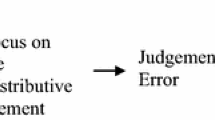Abstract
We investigate how a key structural aspect of negotiation—power—combines with aspiration level to affect the interaction pattern of negotiators. Conflicting research findings have revealed that in most cases negotiators with anequal balance of power reach agreements of higher joint gain than negotiators with an unequal power balance, but in some instances the opposite result has been found. We suggest that it is important to consider the interaction between the negotiators to explain these varying findings. We propose that when unequal power negotiators are able to reach agreements of high joint gain it is due to the efforts of the low power party. In addition, we argue that the low power player will be most likely to drive the search for a solution of high joint gain when he or she also has high aspirations. We tested these proposals in a market negotiation with integrative potential. To examine the pattern of negotiation, all offers and counter-offers were written. The results indicated that overall, equal power dyads achieved higher joint outcomes than unequal power dyads. Under unequal power, the hypothesis that higher joint outcomes would be obtained when the low power player had high aspirations received partial support. In addition, support was found for the hypothesis that in unequal power dyads low power players would be responsible for driving solutions of higher joint gain.
Similar content being viewed by others
References
Bazerman, M.H., T. Magliozzi, and M.A. Neale (1985). “Integrative Bargaining in a Competitive Market.”Organizational Behavior and Human Performance 34, 294–313.
Komorita, S., J. Sheposh, and S. Braver. (1968). “Power, the Use of Power, and Cooperative Choice in a Two-Person Game.”Journal of Personality and Social Psychology 8, 134–142.
Lax, D.A., and J.K. Sebenius. (1986).The Manager as Negotiator. New York: The Free Press.
Mannix, E. (in press). “Coalitions in the Organizational Context: The Effects of Power Balance on Coalition Formation in Small Groups.”Organizational Behavior and Human Decision Processes.
McAlister, L., M.H. Bazerman, and P. Fader. (1986). “Power and Goal Setting in Channel Negotiations.”Journal of Marketing Research 23, 238–263.
McClintock, C.G., D. Messick, D. Kuhlman, and F. Campos. (1973). “Motivational Bases of Choice in Three-Choice Decomposed Games.”Journal of Experimental Social Psychology 9, 572–590.
Neale, M., V. Huber, and G. Northcraft. (1987). “The Framing of Negotiations: Contextual Versus Task Frames.”Organizational Behavior and Human Decision Processes 39, 228–241.
Neale, M., and G. Northcraft. (1991). “Behavioral Negotiation Theory: A Framework for Conceptualizing Dyadic Bargaining.” In B. Staw and L.L. Cummings (eds.),Research in Organizational Behavior. Greenwich, CT: JAI Press.
Pinkley, R., M. Neale, and R. Bennett. (in press). “Alternatives, Reservation Prices and Outcomes: The Impact of Alternatives to Settlement in Dyadic Negotiation.”Organizational Behavior and Human Decision Process.
Pruitt, D.G. (1981).Negotiation Behavior. New York: Academic Press.
Pruitt, D. (1983). “Integrative Agreements: Nature and Antecedents.” In M.H. Bazerman and R.J. Lewicki (eds.),Negotiating in Organizations. Beverly Hills: Sage.
Roloff, M., F. Tutzauer, and W. Dailey. (1987). “The Role of Argumentation in Distributive and Integrative Bargaining Contexts: Seeking Relative Advantage But at What Cost?” Paper presented at the First International Conference of the Conflict Management Group, Fairfax, VA.
Sheposh, J., and P. Gallo. (1973). “Asymmetry of Payoff Structure and Cooperative Behavior in the Prisoner's Dilemma Game.”Journal of Conflict Resolution 17, 312–333.
Sondak, H., and M. Bazerman. (1991). “Power Balance and the Rationality of Outcomes in Matching Markets.”Organizational Behavior and Human Decision Processes 50, 1–23.
Tedeschi, J., T. Bonoma, and N. Novinson. (1970). “Behavior of a Threator. Retaliation Versus Fixed Opportunity Costs.”Journal of Conflict Resolution 14, 69–76.
Author information
Authors and Affiliations
Rights and permissions
About this article
Cite this article
Mannix, E.A., Neale, M.A. Power imbalance and the pattern of exchange in dyadic negotiation. Group Decis Negot 2, 119–133 (1993). https://doi.org/10.1007/BF01884767
Issue Date:
DOI: https://doi.org/10.1007/BF01884767




